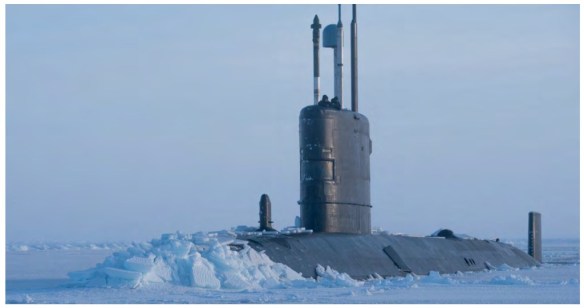Whilst having the appearance of a Bugs Bunny-style navigational error, the Trafalgar-class fleet submarine HMS Trenchant dramatically breached a metre of Arctic sea ice as part of Ice Exercise 18 (ICEX) this March as part of a series of demanding trials for the submarine’s crew. During the major exercise, Trenchant joined two American submarines, the USS Connecticut and USS Hartford, while crews and scientists conducted their research on the ice in conditions as cold as -40°C. Additionally, the crew paused for a service to remember two submariners killed on an ICEX in 2007, after an accident onboard HMS Tireless.
The British nuclear-powered submarine programme began with HMS Dreadnought, which was completed in 1963. She was followed by the five boats of the Valiant class. and all six had been retired by 1991. Their successors were the six Swiftsure class boats completed between 1974 and 1981 of which five remain in service (Swiftsure decommissioned in 1992). Displacing 4,400 tons standard, they have been constantly updated in periodic refits, and Splendid was the first British submarine to fire the Tomahawk SLCM, in October 1998. However, she was retired in 2003, and Spartan followed in 2006.
The Swiftsure design was basically repeated with improvements and modifications and named the Trafalgar class. The name ship was laid down in 1979 and commissioned in 1993. She was followed by Turbulent (1984), Tireless 11984), Torbay (1987), Trenchant (1989), Talent (1990) and Triumph in 1991. These are slightly larger than the Swiftsure class but carry a similar armament including Harpoon anti-ship missiles, Tomahawk cruise missiles and Spearfish long-range torpedoes. A prominent feature of both Swiftsure and Trafalgar class submarines is the coating of the hull with anechoic tiles to reduce reflections from active sonars. Unfortunately these have a tendency to come adrift over a period of time and it is rare to see one of these boats without several tiles missing.
All Trafalgar class boats are being progressively updated as they come in for refit and refuelling, and this includes the fitting of Type 2076 hull-mounted active/passive sonar, SMCS (submarine command system) and Tomahawk capability. Diving depth is quoted officially as 1,000ft (300m) but is probably greater than that.
The Trafalgar class boats are claimed by the Royal Navy to be the quietest submarines in service, quieter even than the diesel-electric Oberon class.
The Trafalgar class are hunter-killer fleet submarines. They were the replacement for the Swiftsure class and have been used throughout the world, but most notably in operations concerning Afghanistan, Iraq and Libya. Of the seven boats built, HMS Trafalgar was fitted with a conventional propeller, the only one of the class not to have a quieter pump-jet propulsion system.
Submarines from the class have seen service in a wide range of locations, and have fired missiles at targets in Afghanistan, Iraq and Libya. HMS Torbay, Trenchant, Talent and Triumph have been fitted with the Sonar 2076 system, which the Royal Navy describes as the most advanced sonar in service with any navy in the world.
HMS Turbulent. She was commissioned on 28 April 1984. The end of the Cold War effectively made the hunter-killer role of the Trafalgar class redundant. Turbulent has been used subsequently to drop commandos for clandestine operations, as well as in the Iraq War, when she fired Tomahawk missiles in support of the invasion. She was used in the intervention in Libya in 2011, but has now been decommissioned and awaits disposal.
HMS Triumph She is based at Devonport and was the last of her class to be built. She is scheduled to be decommissioned in 2022. In 1993 she travelled 41,000 miles unaided and without support. This remains the longest ever solo deployment by a Royal Navy submarine.
The next nuclear-powered attack submarines for the Royal Navy will be the Astute class, closely based on the Trafalgar class, and the first boat entered service in 2014, with Ambush and Artful followed in 2013 and 2016.
SPECIFICATION
Type: SSN Class: Trafalgar
Displacement: 4,740 tons surface, 5,208 tons dived
Length: 280.1 ft (854m)
Beam: 32.1It (9.8m)
Draught: 31.2ft (9.5m)
Machinery: nuclear; 1 Rolls-Royce PWR reactor; 2 GEC turbines, 15,000hp; 1 shaft, pump jet propulsor; 2 turbo generators, 3.2MW; 2 Paxman diesel alternators, 2,800hp; 1 motor for emergency drive; 1 auxiliary retractable propeller
Speed & Range: 32kt dived
Complement: 130
Missiles: Hughes Tomahawk Block III submarine launched cruise missile ISLCM); Boeing UGM-84B Sub Harpoon Block 1CSSM
ASW & USW: 5 21 in 1533mm) torpedo tubes, Marconi Spearfish or Tigerfish Mk. 24 dual-purpose wire-guided torpedoes
Sensors: radar: Type 1007 navigation; sonar: Type 2020 or 2074 or 2076 hull-mounted low-frequency active/passive search and attack; Type 2007AC or Type 2072 hull-mounted passive flank array; Type 2046 passive towed array; Type 2019 or Type 2082 passive intercept and ranging; Type 2077 short-range active classification
